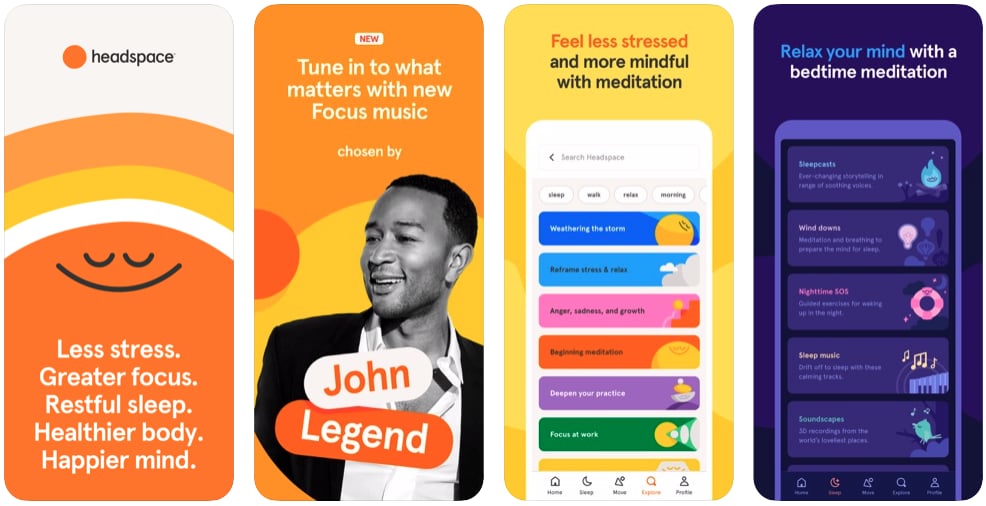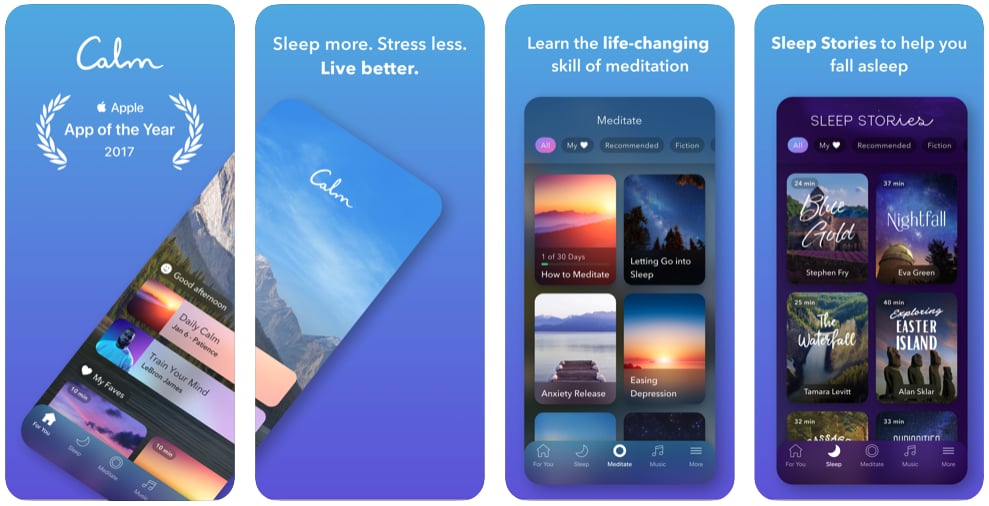
Meditation is ideal for when you're feeling anxious [1] or just want to be more centreed. Think of it as an exercise for your brain. Just as you need to get your blood flowing, heart pumping, and your muscles engaged, your brain needs to pause in order to become stronger. Meditation is a beautiful practice in and of itself that allows you to feel calmer and more thoughtful, but it can also have incredibly positive affects on your focus, mood, and energy levels.
Meditation apps are a no-brainer (ha!) because they let you meditate on the go, and are quick, easy, and effective. You can meditate during your commute, over your lunch break [2], or in the more traditional setting on a yoga mat or cushion in your home [3]. Whatever you choose, the most important thing is to just do it, and these apps make meditating easier than ever. The question then becomes, what app should you choose? Here, we break down the pros and cons of two of the most popular — Headspace and Calm — so you can make the best decision for you.
 Image Source: apps.apple.com [4]
Image Source: apps.apple.com [4]
What You'll Get From Headspace
Headspace [5] ($70 per year after a free trial) is an app that, just like Calm, makes meditation and sleep much simpler. Their motto is to promote living "a healthier, happier, more well-rested life in just a few minutes a day," and from the get-go, you can appreciate the app's straightforward nature and simplicity.
As soon as you open the app in the morning, you're greeted by "The Wake Up," a fun video that's designed to help you set the tone for your day. As you scroll, you'll find "Today's Mindful Moment," a proverb or mantra-like piece of text, and further on, a written story from someone in the Headspace community, with a response from Headspace's cofounder Andy Puddicombe. Once you get started, you'll find your recent meditations on this front page, in case you want to jump back in. At the beginning, all of this content is pretty interesting, but it can make the app's interface seem less intuitive when you just want to get your meditation on.
Headspace's bottom tabs include "Meditate," "Sleep," "Move," and "Focus." As soon as you click "Meditate," you're transported to different featured courses and guided meditations. Here, you'll explore meditations catalogueed by themes, such as acceptance and coping with cravings, which is a quick way of dealing with specific types of anxieties and other emotions. You'll also find SOS meditations for when you're panicking or losing your temper, meditation techniques and support, and timed meditations that allow you to tailor your practice to your schedule. Moreover, the "Sleep" tab includes sleepcasts, or sleep-focussed storytelling, sleep meditation wind downs [7], exercises for when you randomly wake up at night, and soothing sleep music.
This app's "Move" tab really sets it apart, with an entire exercise and movement portion within its interface. Quick workouts, mindful cardio, and different kinds of exercise courses are complemented by rest day meditations and even mental fitness solutions for optimum performance. Last but not least, the "Focus" tab provides you with ambient music, perfect for homework or any other kind of task, and includes playlists by John Legend [8], focus exercises, and soundscapes from the world's most beautiful places.
 Image Source: apps.apple.com [9]
Image Source: apps.apple.com [9]
What You'll Get From Calm
Calm [10] ($70 per year after a free trial) is another app that was created to help centre, relax, and focus its users, utilising creative, innovative techniques to achieve this goal. Initially, what sets Calm apart from any other meditation app is its bright, super intuitive interface that sets you right in a meditative sphere, paired with incredibly unique collaborations with celebrities, including prominent athletes and musicians. In a sense, it's fun and entertaining, which is great for people who aren't usually into meditation or are just starting out [11].
This app's welcome page immediately lands on an idyllic natural escape, and with just a quick scroll, you're presented with the "Daily Calm" meditation, which changes every day. In exactly 10 minutes, you're transported into total relaxation, guided by a voice that reminds you it's OK if you're not meditating "perfectly." Continue scrolling for mini podcast-type features with people such as Ageist founder David Stewart — just about seven minutes long for a quick burst of positivity — and other featured collaborations. A "Quick and Easy" section is perfect for when you need to quickly calm your anxiety or scan your body for tension, even including a 90-second meditation to calm anger and a two-minute deep concentration meditation. Calm's intuitive nature guides users right into the thick of it, resulting in the epitome of a user-friendly experience.
Calm's "Mental Fitness" section features an incredible collaboration with LeBron James on how to train your mind. "Sleep Stories" bring a whole new meaning to the art of the bedtime story and include one narrated by Harry Styles [12] (swoon!), which is dreamy in every sense of the word. Continue scrolling for more meditations for your every need and mood, as well as an entire "Music" section featuring calming music by Sam Smith, Sabrina Carpenter, and Diplo, with exclusive Calm remixes. The tabs on the bottom of the app take you to landing pages specifically for each of these sections, with a wider array of content, but you can also get everything you need right on the homepage.
So, Which App Should You Choose?
With something as personal as meditation, it's important to try several options until you find what works for your body and mind. The truth is that what works for one person might not work for another. However, when it comes to the multitude of features each of these apps provide, Calm is without a doubt more user-friendly and more innovative in terms of content, giving you more bang for your buck. Headspace has fewer bells and whistles. That said, if you don't need any bells and whistles to get into a guided practice, and you like having a fitness component within the app, it may be the better choice. Both apps offer deep, effective meditations that can truly change your life.
It goes without saying that whatever you choose, the important thing is to just meditate, whenever and however you can. On the bus, on the train, with or without an app!

